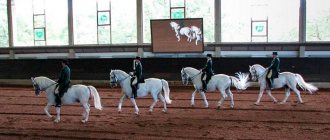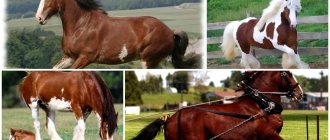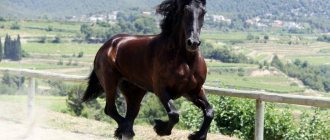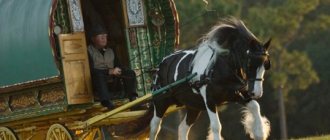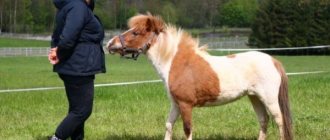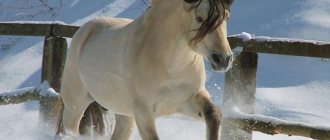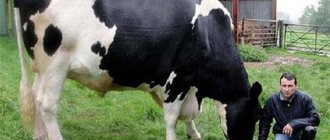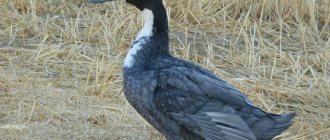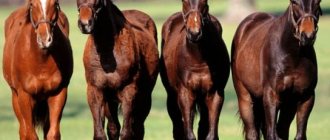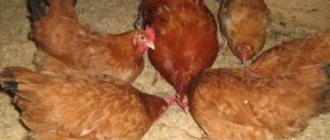Man's love for horses dates back thousands of years. This animal has always been his first assistant: in work, in battle and in rest. There are now more than 400 horse breeds in the world. A special place among them is occupied by riding horse breeds. The popularity of racehorses continues unabated and each new generation discovers the beauty and grace of a running horse. Moreover, the passion for horses in the world is constantly growing: some are interested in them simply for the soul, some make money by betting on horse races, and some collect expensive horses.
Did you know? The most expensive stallion was Shareef Dance (a thoroughbred horse breed), which was sold in 1983 for $40 million in the USA.
History of the breed
Great Britain, since the time of Julius Caesar, has been famous for its agile and strong horses. But with the advent of firearms in battles, speed, endurance and maneuverability came into first place. But the massive horses of that time did not meet these requirements, which prompted English horse breeders to create a new, fast and maneuverable breed. Purebred riding horses appeared in the 17th - 18th centuries in England. Their ancestors are the horses of the East. Selection was carried out using the method of strict selection based on the results of races. The British call thoroughbreds “bred to perfection.”
As a rule, queens from royal breeding plants were taken as the mother stock, which had admixtures of Spanish, Eastern and Hungarian breeds. 50 mares were selected, which marked the beginning of a new breed of thoroughbred horses. More than 200 stallions, mostly of oriental origin, were also selected for crossing. But only three of them became the founders of the thoroughbred riding breed: the Turk Bjerley (came to England in 1683), the Darley Arabian (brought in 1710) and the Godolphin Barb (used from the 1730s).
The first stallion, Turk Bjerlei, was captured by Captain Bjerlei during the siege of Buda. This stallion proved to be an excellent sire and became the founder of the line of English Thoroughbred riding horses. The most famous representative of this line, Herod, was born in 1758 and became an outstanding sire.
The second of the three founders is Darley Arabian. It was born in 1700 and was acquired by Thomas Darle in 1704 in Syria. After this, the stallion was transported to England, where it was used for crossing and breeding new breeds. Darley's most significant crossings were with the mare Betty Leeds, which resulted in the birth of the stallions Chalders Barlet and Flain Chalders, who also played an important role in the development of the thoroughbred riding breed. Of the 3 founder stallions of the breed, Darley Arabian was the most important.
Godolphin Barb - the last of the 3, was born in Yemen. Then he was sent to Syria, then to Tunisia - as a gift to the King of France. There are 2 versions of how Godolphin Barb came to England. According to one of them, it was bought by the English Edward Cook, according to another - Count Gedolphin. The mating of Godolphin Barb with the mare Roxanne produced Les, the most famous English racehorse since Flynn Chalders. In 1850 it was noted that there was a Godolphin Barb descendant in every stable in England.
Classification
According to the exterior and general constitution, which largely depend on the appropriate upbringing and feeding, a distinction is made between draft horses (heavy-duty, agricultural, carriage or saddlery), riding and pack horses, trotting and racing horses.
Various horse breeds are grouped by:
- zonal and climatic characteristics:
forest; - steppe;
- mountain;
- riding;
- cultural;
- factory;
In the Soviet Union, a comprehensive classification of horse breeds was adopted, which, on the one hand, took into account the type of economic use, on the other, the degree of influence of natural and artificial selection, as well as the natural zones that formed the breeds.
In accordance with this classification, breeds are divided into:
- factory
(the predominance of artificial selection, increased demands on housing and feeding conditions, which pays off with increased performance and specialization). They are divided into: riding; - light-harnessed;
- heavy-duty;
(best adapted to natural conditions, unpretentious and undemanding, but small and less efficient). They are divided according to the natural zones in which they were bred and to which they are adapted:
- northern forest;
(often created by crossing the first two types). They simultaneously have signs of division of both local and factory breeds, but economic specialization (riding, draft or heavy draft type) is less pronounced in them than in factory breeds.
Pony
Breeds of ponies
(the smallest horses) can also be classified as:
- local (for example, the smallest Shetland pony, crushed in the harsh conditions of the Shetland Islands)
- transitional (improved by factory breeds) (Welsh)
- even almost factory-made ones, bred in the 20th century specifically for children's sports (riding ponies (name of breeds) in England and Germany)
The height bar for ponies in Western Europe is very high (up to 140 cm), and practically both steppe and northern forest horses have to be included in this group according to the Western classification.
Draft, or draft, breeds have been bred for a variety of agricultural work since the Middle Ages.
Draft horses are large, calm, strong horses.
Suffolk breed
Of course, now their use as draft power has noticeably decreased, but this does not prevent the preservation of such breeds as:
- Clydesdale;
- Suffolk and Shire in England;
- Ardennese in a number of Western European countries;
- German Mecklenburg draft;
- Norikean;
- Rhenish-German;
- Rhenish-Westphalian;
- Saxon-Thuringian;
- Schleswig
And some other breeds of heavy trucks (for example, Württemberg) are reoriented towards sports. English breeds of heavy draft horses played a decisive role in the development of a number of similar breeds in Russia.
By characteristics
The classification of horse breeds has not yet been fully developed.
Based on skeletal structure and other characteristic general differences, the numerous horse breeds can be reduced to the following three types:
- Norian (aka Lowland, European, Germanic, Northern, Occidental).
- Eastern (oriental, or Arabic).
- Mongolian.
In addition to purely zoological characteristics, the difference between them also manifests itself in other, purely agricultural ones.
Eastern type
Characterized by a small and wide head, large eyes and a “pike” profile. All the bones of both the skull and the entire skeleton are thinner, but denser than those of the Norian.
The Eastern is smaller in stature than the Norian, narrower, drier, later ripening, feeds and holds the body worse, and therefore is pickier and more voracious in feeding, not so strong, but faster on the move, hardy, energetic, willful, more intelligent (A. Armfeld) .
List of breeds:
- Arabic;
- English thoroughbred;
- Akhal-Teke;
- Anglo-Norman;
- Percheron;
- Belgian;
- Azerbaijani: Karabakh horse;
- Deliboz;
- Cuban pacers;
Norian type
Clydesdale
has a developed facial part at the expense of the cranial part, the entire skull is longer and narrower, the eye arches protrude slightly, the profile of the head is convex, especially in the nasal part.
The Norian horse is large, massive, rich in muscles, has powerful bones, is precocious, digests food well and holds the body, is strong, not particularly hardy, is not fast on the move, obedient, lethargic, phlegmatic, cold-blooded, less intelligent, etc.
Western breeds received the name Norian due to the Pinzgau breed.
List of breeds:
- Clydesdale;
- Bityug;
- Swedish (horse breed);
- Don horse;
- Oryol trotter.
Swedish
For the small Norian horse, the breeds common throughout the north of Europe under the name Norwegian, Breton, Norman, etc. are extremely typical.
These are small horses, adapted to areas with poor food, and are equally suitable for work and riding. This also includes various ponies, such as Scottish, Welsh, Exmoor, New-Farest, but their performance is insignificant.
In Russia, several subbreeds of this type are distinguished, which have received greater or lesser independence; Of these, the most remarkable are two kleppers and a Swede.
A more or less pure type of Norian horse is also represented by the Zhmud, Obvinsk, Vyatka, Kazan and Mezen horses, also of a fairly constant breed; different colors, not savrasaya, red and nightingale, with a belt on the back, is considered especially typical.
Under the influence of unfavorable feeding conditions and poor selection of breeds (except for Zhmud), they gradually degenerate, and large horses are the exception among them. Peasant horses should also be included here.
Mongolian type
In terms of dry build and height it is close to the eastern one, but the special structure of the skull, different from the first and second types, and the absence of chestnuts on the hind limbs (horny warts on the inner surface of the legs) force it to be distinguished into a special group.
The Mongolian type has many representatives in the steppe part of Russia. The conditions of their keeping are very different from the usual raising of horses.
Both among nomadic peoples and among some breeders, horses are divided into separate schools or herds; each such group consists of mares, numbering from 10 to 20, with sucklings, one and two years old, under the leadership of one stallion.
Such maintenance is the main obstacle to the improvement of steppe horses by stallions of cultivated breeds that cannot stand the conditions of herd life, and in addition, it is always very difficult to feed and properly raise foals.
Of the steppe horses, which are generally more suitable for riding, the most common are the Kyrgyz.
Not all existing breeds, however, fit into this group. Many of them represent horses of mixed origin, resulting from crossbreeding, which was especially often practiced between horses of the Eastern and Norian types.
In terms of numbers, the Mongolian type of horses, better known as steppe horses, predominates. According to the Chinese, horses of this type are tamed for 6000 hp. ago.
From the Asian steppes, where they are mainly bred, in connection with the settlement of the Turks in the 4th century. They also settled in the steppes of southern Russia and the deserts of Hungary.
The more cultured eastern horse has become known since the time of the Prophet Muhammad, who even included the breeding of noble horses in the code of religious beliefs.
Since the Crusades, the eastern horse has become widespread and has had a decisive influence on the transformation of European horse breeding.
The Norian horse had two representatives in prehistoric times: one small, the other large type. It is believed that modern ponies and the small native breed of horses of the northern states originated from the first, and the heavy trucks of Central Europe originated from the second.
The breeding of the latter was greatly influenced by the development of medieval knighthood, since their heavy weapons required horses of considerable strength and size.
From the continent she is in the 12th century. was transported to England, where, under the influence of abundant feeding, it reached a truly enormous size.
Show horses
There is a special category of horses of rare colors that can move with special types of gaits. These are the so-called show horses: American Cream and White, Appaloosa, Palomino, Pinto, Paso Fino, Missouri Foxtrotter, Falabella, etc.
Over the past ten to twenty years, even specialized breeds of horses for show have appeared:
- American Golden Horse;
- American miniature;
- araappaloosa (a derivative of the Arabian horse and the forelock appaloosa);
- Quarab (a derivative of the Quarter Horse and Arabian breeds);
- Morab (a derivative of the Morgan and Arabian breeds);
- Pintabian (derived from the Arabian and Pinto horse breeds);
- national show horse (a derivative of pure “Arabs” with a large American horse);
- river horses (have a special gait, not similar to the usual walk, trot or amble).
What are the characteristics of riding horse breeds?
All riding horses are divided into two categories. The first ones are intended for recreational driving. These are mainly bred for training and personal pleasure. They are distinguished by a calm, kind disposition, and flexible.
The second type is sports horses, which are used for short and long distance races. These handsome men have a very proud disposition, are strong, persistent, and sometimes nervous. Very often they have an explosive nature and often only allow one rider - the owner. They need frequent and heavy exercise, unlike walking breeds.
All riding horse breeds, despite their differences, have approximately the same height - within 153-160 cm at the withers and a light build. In terms of physical features, it is worth highlighting the slanted shoulders and long, muscular back. They are also very fast, and some, such as the Ukrainian, Akhal-Teke or Thoroughbred, are hardy.
Frieze
The Friesian horse is a Dutch breed, “the black gold of Holland.” Bred in Friesland, first mentioned in the 13th century, now bred in Europe and America. Horses range in height from 150 to 162 cm and have an elegant appearance. A memorable feature is the long thick brushes on the legs, the so-called friezes. Suitable for keeping in stables, somewhat picky about feed.
Friesian horse: Wikipedia
What is special about the Friesian horse? Today, friezes are decorative horses. They are energetic, but balanced and calm. They are often used for festive or ceremonial carriages, photo shoots, and filmed.
English racing horse (thoroughbred)
The main reason for the appearance in England of the 17th - 18th centuries. The breed of English racehorses became a war. Sluggish knights in armor with heavy spears were replaced by cavalrymen armed with sabers and pistols. Instead of powerful, strong horses, hardy, but nimble and fast animals were needed. Horses from the royal stables were used as the basis for selection: 50 mares (from Hungary and Spain) and 200 stallions (eastern horses). Three stallions received particular fame as the founders of the new breed:
- Turk Bijerlei (named after the captain who captured a horse from the Turks in the battle for Budapest), came to England in 1683;
- Darley Arabian (brought in 1704 from Syria) - his descendants played a particularly important role in breeding a pure breed;
- Godolphin Barb (from Yemen came to Tunisia, was brought to France as a gift to the king, was used there as a water carrier and was bought by Count Gedolphin in 1730), he gave especially numerous offspring - in 1850 one of his descendants was present in every English stable .
The first name of the new breed sounded like “English riding horse breed”. After it spread throughout the world, the name became obsolete. Now it is called a “purebred horse” or Thoroughbred horse.
Did you know? The Thoroughbred is the fastest breed of racehorse. No other horse can keep up with them. The absolute record belongs to the stallion named Beach Rackit - 69.69 km/h.
Feeding and care
Content depends on climate:
- If it is cold, then in winter the animals are driven into stables. Daily walks are important. In warm weather, horses are constantly outside, in the pasture.
- In mild climates, horses are kept outdoors. An exception is made only for mares and foals, but only during bad weather. They are sent to the pen. Stallions seek shelter on their own.
On the contrary, food is troublesome. Athletic Dutch people need an enhanced and varied diet:
- hay;
- fresh grass;
- cereals, beans;
- vegetables;
- vitamins, minerals and more.
They feed three times a day. They try to do this at the same time. They drink before eating. In summer you will need approximately 60 liters per day. Lifestyle and training have an impact.
Dutch warmblood horses are favorites in their homeland. The breeders have done serious work, and their efforts have paid off. The result was fleet-footed, graceful horses with an easy-going nature.
Arabian purebred
The Arabian horse breed is very recognizable. It is worth looking at it at least once and you will remember it forever. This is one of the ancient racing breeds that appeared in the 4th-7th centuries. Among its ancestors are Akhal-Teke, Parthian and North African horses. The advent of Islam and the beginning of the Arab conquests accelerated the process of selection - for success in battle, not only a Baghdad blade was needed, but also a fast, tireless and hardy horse. The main measure of wealth among the Bedouins were Arabian horses: the more livestock a person owned, the higher his status. During campaigns, Arab warriors took care of their horses more than themselves: they fed them with barley, dates, and kept them in their tents.
Arabian horses came to Europe during the Crusades.
The exterior of Arabian horses bears the imprint of the Arabian deserts: small height (1.4-1.57 m), medium-sized body, dry constitution, small head with large black eyes, wide forehead, slightly concave bridge of the nose, and widened nostrils . The neck is curved, the legs are quite long. The tail with a well-developed rib (root) rises in an arched manner while running (this is one of the distinctive features). Other features include having only 17 ribs (other animals have 18) and fewer caudal vertebrae
Experts identify three pure exterior lines and two mixed ones:
- Koheilan. It is famous for its strength and good endurance. Excellent horses. The majority are red and bay.
- Siglavi. The breed properties are more pronounced, they are lighter, less tall, have an average constitution, and their racing qualities are less pronounced. The color is predominantly grey.
- Hadban. Breed traits are least pronounced. Larger in size and more durable.
- Koheilan-siglavi, siglavi-habdan - combine features of different types. The most common color is gray (of different shades, including “buckwheat” or mottled). More rarely - roan (sabino), bay, white, red. Black and silver bay horses are the least likely to be found. While inferior in speed to purebred riding horses, this breed has more balanced qualities: within 6-7 days the animal can travel 100 or more kilometers, tolerating the heat well. Life expectancy is more than 30 years. Horses are in good health, rarely get sick, and produce numerous offspring. Temperament is more sanguine, they easily make contact, and are easy to train and train.
Did you know? Muslim tradition associates the appearance of Arabian horses with Muhammad. On the way from Mecca to Medina, the Prophet met beautiful mares. Seeing an oasis on the way, all the horses rushed to the water, except for the five best. They gave rise to the Arabian horses.Although for centuries the main suppliers of Arabian horses were the Arabian Peninsula, Syria, Egypt, and Turkey, today the center of their breeding has moved to Europe, America, and Australia. Arabian horses are among the most popular in the world today.
The economic importance of these horses has decreased. Today, their main use is sports (hurdle racing, vaulting, show jumping), equestrian tourism, festivals and shows, hippotherapy, etc.
The ancient practice of selection has not lost its relevance, because the blood of Arabian horses can improve the breeds of other horses.
Important! Arabian, Akhal-Teke and thoroughbred horse are the real three purebred breeds, bred without the participation of foreign blood.
Icelandic
The Icelandic horse is a short horse, whose height at the withers reaches 132 cm. It has different colors, from red to bay. Icelanders have about 100 shades of animal color. The breed was brought by the Vikings to Iceland in the 9th–10th centuries, as it easily fit in their ships.
Icelandic: Wikipedia
What features distinguish the Icelandic horse? These are very smart horses. They have excellent body balance, thanks to which they can easily overcome any obstacles. During their history, the animals have never encountered predators, so they easily trust people and have a calm and friendly character. Suitable for herd keeping.
Akhal-Teke
Akhal-Teke or Akhal-Teke is an eastern riding horse that appeared in the 3rd millennium BC. in Central Asia in the Ahal oasis. These animals were bred in the Parthian kingdom, in Persia. Many commanders appreciated the high qualities of the Akhal-Teke horses, but the purity of the breed was preserved only in Turkmenistan - the nomads literally idolized the horses. The owner shared bread and shelter with the horse.
Did you know? Marco Polo testified that Alexander the Great's favorite horse, Bucephalus, was an Akhal-Teke. The commander founded and named a city in his honor (now it is the city of Jalalpur in Pakistan).
The Akhal-Teke exterior was historically formed in the hot desert.
Horses of this breed are lean and quite tall (from 1.55 to 1.63 m). Their back and legs are long, their croup is slightly drooping. The head is small, graceful in shape with almond-shaped eyes. The ears are mobile and long. The profile of the head is slightly hook-nosed. The neck is long and thin. The hooves are small. Distinctive features include:
- special gaits (developed in sand dunes). The walk, trot and gallop have a high amplitude, movements are performed smoothly.
The color is the most varied (black, bay, dun, etc.). A rarer color is isabella and silver.
The character of Akhal-Tekins is ardent, their temperament is choleric. Horses are very touchy, proud and independent.
Important! Akhal-Teke horses require a special approach, constant contact with the owner: they become strongly attached to a specific person (like dogs), do not get along well with other people and cannot tolerate a change of owner (they are often called horses of one owner).
Akhal-Teke horses are used for riding, in sports (horses, distance running), and in falconry. They reach their best shape by the age of 4-6 years. They tolerate heat well and are hardy.
The largest populations of Akhal-Teke horses are in Turkmenistan, the Russian Federation, Europe and the USA.
Selection rules for breeding
Animals for further selection are selected very strictly, focusing on established standards and requirements. Mares that meet the standards undergo a mandatory veterinary commission. They take tests to reveal hidden pathologies. Suitable individuals are assessed by experts for physical fitness.
The requirements for stallions are even higher. The commission checks not only their state of health, pedigree and compliance with conformation standards, but also their ability to follow commands, temperament and productivity of movements. Experts assign different ratings to stallions:
- Selected (keur). This means that the horse is approved for breeding, but meets the basic selection criteria.
- Preferred. This is the highest assessment of compliance with the commission's requirements.
A similar classification applies to mares, only they are assigned a certain status depending on how many top foals the female produced.
Attention! Animals that have passed a thorough selection are given elite status and are included in the stud book. Such horses are very expensive, but despite this, they are in great demand among athletes
Budennovskaya
The official date of birth of this breed is November 15, 1948. On this day, a special resolution of the USSR Council of Ministers was issued on the recognition of the breed named after Budyonny. Selection began in the 1920s, under the supervision of Marshal of the Cavalry S. Budyonny. It was necessary to create special “army” horses. The basis was taken from mares of the Don breed of horses bred in Russia and purebred riding stallions. When the need for army horses disappeared, these horses, with good racing qualities, began to be actively used in sports competitions (horse racing, eventing, show jumping, etc.).
The exterior of Budennovsky horses provides for a height of 1.6 to 1.8 m and can have three body structure options:
- massive (with a strong constitution, developed muscles and bones);
- characteristic (combines massiveness and dryness, animals are more playful);
- eastern (dry constitution, more rounded decorative forms, animals have good endurance, but are more demanding and capricious). The color is distinguished by a predominance of shades of red (with a golden tint). The head is dry, has a straight profile, proportional. The back and croup are long and powerful. The hock joints are highly developed.
Proper feeding of horses is the most important factor; their diet should include: corn, sorghum rye, fescue, barley, wheat and hay.The main breed qualities: performance, strength, endurance, excellent racing ability, beauty. The main breeding centers are located in the Rostov region of the Russian Federation - horse (formerly Yulovsky), named after. The First Cavalry Army and them. Budyonny.
Hanoverian
The Hanoverian breed was developed in Germany (Lower Saxony). The first mention of it occurs in the 8th century. (Poitiers Charles Martel stopped the Arab invasion). They were famous for their power and strength (they wore armor and knights in armor). Elector of Saxony George I in the 18th century. brought horses from Spain, England, and Arabian horses to freshen the blood. After the Napoleonic Wars, a new stage in the improvement of Hanoverians began - crossing with racing breeds (purebred, Trakehner, Arabian). The Hanoverian breed was finally formed in the middle of the twentieth century. These horses, with medium agility, strong jumping and great strength, are ideally suited for sports competitions (jumping, eventing, dressage).
Modern representatives of the Hanoverian breed look very much like purebred riding horses, but are distinguished by their height (up to 1.7 m), well-developed muscles of the body and croup, and a longer neck. The head is of medium size. The color is the most varied, most are monochromatic, but white spots are often found.
Horses of the Hanoverian breed are distinguished by their balanced character and are persistent.
Selection work includes a hundred-day test for stallions (temperament, performance, correct jumping and other qualities are assessed).
Historical reference
In the 16th century, the County of Oldenburg needed strong and durable horses, which would also have pronounced draft qualities. In 1573, when Johann IV began to govern the county, he decided to create a new breed of horse. To accomplish this task, he organized several stud farms and reconstructed existing ones.
After the death of the Count of Oldenburg, control was taken over by his successor, Anton I. The first crossbreds turned out to have a strong physique, strong and hardy, but they did not have beautiful harness gaits. The breed needed improvement.
In the mid-17th century, it was decided to infuse the Oldenburg horses with fresh blood from Iberians and Neapolitan horses. Later, the breed changed again, thanks to the genotype of purebred riding horses and Arabian horses. Now its representatives have acquired beautiful, graceful body shapes, but without compromising their working qualities, and have become more playful.
During the period from the 17th to the 19th centuries, Oldenburg horses had universal use. They were used for light harnessing and field work. The beautiful, stately horse has gained popularity not only in Germany, but throughout Europe.
A sharp turn in the development of the breed
The period of development of mechanization in the 20th century became a real test for Oldenburg horses. At this time, villagers preferred cars to horses. To preserve the breed line, we had to change tactics and start breeding again. Equestrian competitions were gaining popularity, which meant that scientists had to instill new qualities in the breed and make it lighter and faster.
Oldenburg horse at an exhibition
To improve the breed, stallions of Anglo-Norman origin and purebred English and Arabian horses were used. In the 70s of the 20th century, Oldenburg horses were improved with the help of:
- Trakehner;
- Anglo-Arab;
- Hanoverian;
- French horses.
The crossbreeds obtained as a result of long-term selection acquired drier, noble forms and faster speed.
Donskaya
The Don breed was bred during the 18th-19th centuries on the Don by local Cossacks. Don horses were ideal for both agriculture and war. The selection used trophy horses (Karabakh, Persian, Arabian), which the soldiers brought from campaigns. In 1910, Don horses were declared the property of Russia.
The Don horse is inferior in agility to other racing breeds (Ahal-Teke, English, etc.), but in endurance and unpretentiousness it has no equal (it can cover from 100 to 300 km per day).
Did you know? During the war between the British and the Boers (1898 - 1902) in South Africa, all the British horses died, while General French's Don horses (200) survived and served.
During the Civil War, this breed practically disappeared, and its revival took place in the 1920-30s of the last century.
The exterior is distinguished by the massiveness and power of its long body, and its tall stature (up to 1.7 m).
The head is of medium size, the eyes are widely spaced. The long neck forms an arch. The chest and croup are broad and strong, and the long legs have wide hooves. The constitution is strong. The predominant color is red (with a golden sheen). The character is calm.
Today, these horses are used in agriculture, for horse riding training, and in sports competitions.
Working qualities
Breeding working horses is one of the areas of horse breeding. To assess the working qualities of horses, the following indicators were developed and adopted:
- Traction force. Determines the force that an animal applies to move a load, overcoming its resistance to movement. It is noted that three horses create a draft force of 85%, and a team of eight horses creates only 47%.
- Power. The amount of work performed per unit of time, expressed in kilogram meters per second. Formula N=R/t, where power is N, time is t, volume of work is R. In practice, it can be measured in ton-kilometers, hectares. For a 500 kg horse it is 75 kg per m/s or “one horsepower”. When tested at a short distance, individual individuals are capable of exceeding it by 2 or even 5 times.
- Movement speed. Galloping is rarely used for transporting goods or agricultural work. Trotting is allowed for no more than 10-20 minutes, depending on the quality of the road surface. At a trot, the animal gets tired faster. The normal rate is considered to be 60 steps per minute; faster steps lead to decreased performance.
- Endurance. Determines how long a horse can maintain its ability to work and the rate of recovery of the body after a short rest and feeding. An indicator of an animal's fatigue is its pulse, respiratory rate and body temperature. If, after 30 minutes from the moment the work stops, the pulse is above 100 beats per minute, respiration is 70 or above, t -40 - these are clear signs of severe overwork of the horse.
- Friendliness. Characterized by the animal's readiness and desire to work.
Any of the above qualities is important and must be taken into account when breeding horses of heavy breeds. No less significant, and sometimes a decisive factor, is the horse’s good character - the absence of any aggression towards humans and his fellow tribesmen. No strongman can hold back a 900-kilogram raging giant. A calm character and willingness to cooperate are a must when selecting breeding animals.
Kabardinskaya
The Kabardian breed was formed more than 300 years ago in the North Caucasus. To breed it, local steppe horses were used, as well as Arabian, Karabakh and Persian horses, Akhal-Tekins. All year the horses grazed in herds. In the summer - in the mountains (in alpine meadows), wintered in the foothills. This breed feels equally confident on mountain trails and wide steppes, under a rider or in harness.
Average height - from 1.47 to 1.59 m. The exterior is characterized by the following features: a small head has a hook-nosed profile, a strong constitution: a short straight back, a wide chest, dry legs with strong hooves in the shape of an inverted glass. The predominant color is dark. The mane and tail are very thick.
Kabardian horses are divided into basic, eastern and massive types.
The temperament is lively, the horses quickly get used to people and listen well.
This hardy horse is perfectly adapted to ascending and descending in high altitude conditions and to moving on rocky surfaces. In a day's travel, it can cover up to 100 km and transport 150 kg of cargo.
Such animals very rarely get sick and are distinguished by good health and fertility.
The popularity of Kabardian horses is growing: in France, Bavaria, the USA and other countries there is an Association of Kabardian Horse Lovers.
Important! “Warm-blooded” in foreign hippology refers to half-blooded breeds that were bred by infusing “pure” blood from thoroughbred horses. In the future, they need a constant (at least every 4-5 generations) influx of clean blood. “Cold-blooded” refers to local horse breeds that have not been influenced by pure blood.
Types of horse racing
Since ancient times, horse racing has been considered an aristocratic sport that not everyone can afford. If previously only the elite participated in them, today anyone can learn equestrian sports and take an active part in competitions. But the main role in such a sport, of course, is played directly by the horse itself. For a positive outcome, an individual is selected that has unshakable tenacity and temperament, endless strength and endurance, running speed and, most importantly, belonging to a particular breed.
In general, such equestrian sport is divided into three types:
- The racing is smooth, in which the main role is played not only by the speed and agility of the horse, but also by the fighting strategy chosen by the team and the rider. It is on smooth races that the seemingly fastest horse may not come first if its opponents have chosen an effective strategy and tactics for rationally distributing power throughout the entire length of the race. For such races, a round hippodrome is prepared, the distance of which is 1200-2400 m. The main condition for the participation of horses is that they are over three years old. Experts also select breeds that have approximately similar characteristics and capabilities. These can be purebred riding breeds, as well as half-breeds that demonstrate excellent speed.
- Hurdler racing is when special barriers in the form of hurdels are installed at a prepared distance of approximately 2-3 km. Kherdelya - such fences no more than 1 m high, which can fall from a light touch of a horse. In addition to hurdels, wicker fences are installed in hurdle races; they cross the entire width of the running distance. Here, horse breeds are selected that demonstrate excellent jumping capabilities, running speed and endurance. The horse must be at least 3 years old.
- Steeplechase is the most difficult race, for which a circular distance of 2-4 km is prepared. Only horses over 4 years old can take part in steeplechase racing. Fixed types of obstacles are recorded across the entire surface of the running track; one such barrier can have a height of no more than 1.5 m and a maximum width of 6 m. Usually in steeplechase you can see barriers in the form of a stone wall, hedges, and pre-arranged ditches or ditches that even fill with liquid. In this subspecies of racing, the overall and speed endurance of the individual is very important. The main difference between steeplechase and other types of horse racing is the complicated obstacles and the longest race distance.
In general, horses participate in races that have undergone long training and show decent results. Often, if purebred riding breeds are accepted in racing, other pedigrees are not allowed, since few people can compare in terms of characteristics with a thoroughbred horse. The most successful breeds in horse racing are the Arabian, Akhal-Teke and English riding horses.
Terskaya
At the origins of the Terek breed stood another breed, bred in the Lugansk region in the 19th century - the Streltsy. But during the Civil War, the loss of livestock was so great that this breed could no longer be restored.
The color is predominantly silver-gray, less often red and bay.
Temperament - peaceful, balanced. Horses are easy to train, hardy, have good health, and are characterized by longevity and fertility.
Most of the Terek horses are bred at the Stavropol stud farm.
Oryol trotters
Oryol trotters are distinguished by an ideal graceful gait, well-developed limbs and a long, elongated back. The height of the Orlovets is 175 cm.
The most common colors are grey, bay and black, and occasionally piebald. The fur of trotters is soft and thick, plush to the touch.
The breed standard is taken into account with a broad-browed head with an Arabian profile, expressive eyes and small, neat ears.
The neck of these beautifully built, somewhat temperamental, good-natured and friendly horses is crowned with a lush, amazingly beautiful mane, which you just want to touch with your hand.
There are no more horses similar to these types of horses - they are unique. Those who love to ride horses would consider it a pleasure to ride an Orlovets, and athletes most often choose representatives of this particular breed.
Trakehner
The Trakehner horse appeared in Prussia, it belongs to the so-called. "warmblood" horses. The Teutonic knights began to breed this breed (they were granted lands here and brought eastern stallions from Palestine). The birth of the breed took place in 1732, when the Trakehner Royal Stud Farm was opened in Prussia and more than a thousand Arabian, English, and Danish horses were purchased. There was only one goal - to create a universal horse for the army and nobility.
In the 20th century, priorities in breeding Trakehner riding horses changed - they began to be bred as a sports breed. Hippologist breeders, adding the blood of Trakehner horses, the blood of the best breeds of horses for riding, to the blood, were able to create a horse that became famous in many international competitions.
Did you know? At the 1936 Olympics, Trakehner horses brought the German team all the gold awards in equestrian sports.
In 1945, all Trakehner horses were taken to the stud farm named after. Kirov on Don. Due to climate change, illiterate management, and disease, many horses died. The breed was restored only in 1974 (“Russian Traken”).
Height is up to 1.68 m. The main features are a powerful body, oval croup, strong legs with developed joints and powerful wide hooves. The dry, broad-browed head has a straight profile of perfect shape.
They have high endurance (often used in triathlons and crew races) and courage. They are not afraid of sharp sounds and shots.
These animals are also distinguished by the rhythm in all gaits, a wide and light step.
The predominant colors are red, black, bay.
Curious facts
The history of the “Belgians” goes back hundreds of years and contains many interesting facts:
- The breed has been declared a national treasure of Belgium.
- The record holder of the Brooklyn Supreme breed, with a height of 198 cm, weighed 1440 kg.
- The highest price of $47,500 was paid at auction for the seven-year-old “Belgian” Farceur.
- The Belgian horse is not the largest in the world, however, it is the ancestor of the world record giants - the Shire.
- Foals of this breed have their tail shortened at the age of several weeks.
- In the 20th century, the annual export of “Belgians” amounted to up to 30 thousand heads, the lion’s share went to Germany.
- One of the most famous producers, Avenir d'Erze, gave two winners of the breed exhibition in 1933: his son d'Anti and daughter Astrid Pandour received first places.
- Belgian mares are the most likely to produce foals.
- Roan is the most common color of the breed.
- "Belgian" blood flows in the veins of most modern draft horses.
- In 2013, the Oostdunkerk horse-drawn shrimp fishery was included in the UNESCO list of Intangible Cultural Heritage, using only Belgian horses.
In many countries of the world, a reliable human assistant is treated with respect and love. In Russia, in the Yaroslavl region, in the village of Ivashkovo, the “Work Horse Museum” was created. An interesting and educational excursion tells about the role of the horse in the history of Russia, its epic heroes. Introduces the unique breeds of Russia: Altai, Vyatka, Yakut, Bashkir and others. Visitors will learn everything about harnessing and saddling horses, and caring for animals.
Ukrainian riding
This is one of the youngest breeds of riding horses, which appeared in 1990. This was preceded by a long selection process, which began after the Second World War: several stud farms (Alexandria, Dnepropetrovsk, Derkul, Yagolnitsky, etc.) on the initiative of S. Budyonny brought trophy horses from Hungary (Mezohegyes stud), as well as Hanoverian, Trakehner and etc. (a total of 11 breeds were involved).
The exterior combines the best features of the original breeds: tall (up to 1.68 m), strong constitution and bones, dryness, harmonious build, wide back, chest and croup.
Horses of the Ukrainian riding breed are distinguished by their lively temperament, energy, and balance. They are playful and agile, and have high athletic qualities.
Kazakh
Kazakhstan is a unique territory, and the indigenous people differ from us Russians in their mentality. For example, they believe that man’s most important and loyal friends are horses, and not dogs at all.
In Kazakhstan, even now, as in previous centuries, riders are often encountered - and from the outside it seems that man and horse form an eternally fused tandem in these picturesque places.
For the most part, they breed local breeds of steppe horses (adaev and jabe), but they are both called Kazakh.
Kazakh steppe horses are usually kept in a herd, and the herd is grazed year-round - so there is no need to feed them specially, they are able to find grass for themselves under the snow.
When developing the modern breed of Kazakh horses, the blood of Arabian, English, and Don horses was added.
Adays are used as fast-footed racehorses (here the English breed is very influenced).
Their height is up to 145 cm, they have a lively temperament, a light constitution, and their color is bay, white or golden. Horseback riding and racing, easy movement under the saddle, obedience during training - all this is characteristic of the Adaev.
Jabe was a name given to hardy and tenacious little ponies that were adapted to survive in harsh climates. When they were improving their exterior, a drop of Don trotters' blood was added to them.
As a result of selection, horse breeders received very useful workhorses, which can be red, gray or mousey.
In hot weather, both of these Kazakh horses are able to remain without drinking for a long time, and in cold weather they grow thick and long hair.
The best
Very often the buyer wants his horse to be the very best: the fastest, the most beautiful, the rarest, etc. But all the “best” criteria are subjective.
Today the rarest breed in the world is the Terek. But in Russia you can still buy it without much difficulty. But Haflinger, popular in Europe, is much more difficult to get in Russia. But it is possible. But the Rocky Mountain Horse, which is by no means small in its homeland, is one of the rarest in Russia today. So what is the rarest horse breed?
Shires are officially considered the tallest horse breed, growing over 177 cm at the withers. But for some reason they forgot about their closest relatives, the Clydesdales, growing up to 187 cm. And the gray line of Kladrubers, easily reaching the same dimensions as the Clydesdales, only snorts in the direction of the Shires.
On a note! Today, Kladrubers are carefully reduced in size, since large growth has a bad effect on the musculoskeletal system and the health of horses.
Pictured, officially registered as the tallest horse in the world, Shire named Sampson stands 2.2m tall at the withers.
The concept of “the largest horse breed” can also be confusing. If by “large” we mean “tall,” then Shires, Clydesdales, gray Kladrubers and... American Percherons simultaneously claim this title. Given the American passion for gigantism.
If “large” means “heavy,” then this is again a Percheron. But already European, with shorter legs.
The situation is similar with the concept of “the largest breed of horses.” In this case, the word “big” is a synonym for the word “large”.
Even the fastest horse breeds can become confusing. Fast in what area? In classic horse racing, this is the Thoroughbred. In the quarter mile (402 m) race, the Quarter Horse will win. In the 160 km race, the Arabian horse will come first. In a baiga without rules over a distance of 50 km, where the horses always gallop at the limit of their strength, the winner will be an unsightly Mongolian or Kazakh horse.
Important! Calm horse breeds do not exist in nature.
There is only a well-composed diet, thanks to which the horse can bear the required loads, but does not show the desire to play.
It’s better not to mention beautiful horse breeds unless you want to quarrel with a friend. Everyone has their own criterion of beauty. Here it is only appropriate to remember the saying “there are no ugly horses, there are only bad owners.” If a person likes forelock colors, then his standard of beauty will be Appaloosa and Knabstrupper. I like the power - one of the heavy trucks. I like the “figurativeness and cartoonishness” - Arabic siglavi for the show. The list can be endless.
Perhaps only about the smallest breed of horses can we speak more definitely. There are two of them: the Falabella pony and the Miniature American horse.
Falabella is a small, short-legged pony with all the characteristics of a pony.
The American Miniature Horse is proportionally built like a normal large representative of this species. But the height at the withers does not exceed 86 cm.
Interesting! The smaller the Falabella or Miniature American, the more expensive they are.
Yakutskaya
The Yakut horse is an aboriginal horse. Distributed in Yakutia. The breed was developed through folk selection, and not by one or a group of breeders. The Yakuts selected only the most cold-resistant horses for crossing.
What is special about the Yakut horse breed? The breed is very frost-resistant with an undercoat of up to 15 cm. The Yakut horse lives outdoors all year round and is able to withstand frost down to −60 °C. In winter, it feeds on tebenevka (grazing on a snow-covered pasture), raking the snow with its hooves. Horses live in herds.
Yakut: Wikipedia
The height at the withers reaches 143 cm, weight - up to 500 kg. It has a stocky build, short legs and a large head. They are used for horse riding, and kumys is prepared from the milk of mares.
